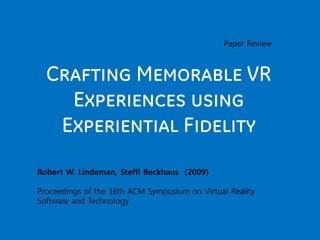Denunciar
Compartilhar

Recomendados
Recomendados
Assessment of HCI in the hardware and software sectors and outlook for the fieldEvaluation of HCI in the software and hardware industry and prediction of HCI...

Evaluation of HCI in the software and hardware industry and prediction of HCI...Bangladesh University of Professionals
Mais conteúdo relacionado
Semelhante a Paper Review 0111
Assessment of HCI in the hardware and software sectors and outlook for the fieldEvaluation of HCI in the software and hardware industry and prediction of HCI...

Evaluation of HCI in the software and hardware industry and prediction of HCI...Bangladesh University of Professionals
Semelhante a Paper Review 0111 (20)
The Role of Virtual Reality in Evolving Animation Journey

The Role of Virtual Reality in Evolving Animation Journey
Evaluation of HCI in the software and hardware industry and prediction of HCI...

Evaluation of HCI in the software and hardware industry and prediction of HCI...
7 factors determining deeper impact of ar based mobile application on user ex...

7 factors determining deeper impact of ar based mobile application on user ex...
Paper Review 0111
- 1. Paper Review Crafting Memorable VR Experiences using Experiential Fidelity Robert W. Lindeman, Steffi Beckhaus (2009) Proceedings of the 16th ACM Symposium on Virtual Reality Software and Technology
- 2. Introduction Today’s virtual environments 1) The potential to achieve a level of realism ex) digital characters in the movie, simulations of crowds 2) Many different types of VR systems for fostering UX [by stimulation of multiple senses, the presentation of interactive content] But, there are limitations 1)IPT, HMD -> large # of technical devices distracting the user. 2)Frame-rate requirements limit scalability 3)# of simultaneous on-screen virtual characters that react to dynamically changing scenes 4)On-line multiplayer systems adds network latency 5)Popularity of mobile interactive systems [w/ reduced display device power, network connections w/ lower bandwidth, higher variability and error rates]
- 3. Introduction These systems provide varying levels of sensory experiences : From fully-immersive, multi-sensory 3D (surround audio, haptic, olfactory cues) To hand-held 2D devices (limited or no audio) But, immersive multi sensory tech doesn’t necessarily lead to a better experience. There is sth lacking : sth beyond sensory fidelity keeping us from fully buying into the worlds we experience through VR tech. So, in this paper, 1)Look at the type of experience a user might have with a virtual environment 2)Explore techniques and guidelines for tapping into the user’s mind 3)Propose a notion of “Experiential Fidelity”
- 4. Experiential Fidelity To improve realism, existing approaches are, 1.sensory-motor attributes : improving visual, audio, haptic, olfactory, gustatory cues 2.Content-driven factors : realism of virtual characters, environment, naturalness of user interaction, evaluation of performance, presence, and perception But, these are not enough to create “good” experiences. Is it because we can’t fully satisfy the expectation of ppl YET? Then, how about using real artifacts? AR : mixing of real-world and computer-generated stimuli Fail to give a higher quality experience
- 5. Experiential Fidelity So, there must be sth beyond the traditional approaches. => Let’s address perceptual aspects i.e. anticipation, expectation, and attitude. Experiential Fidelity : improving the UX increasing the alignment of what the VR experience provides with that which the user is likely to believe. [ To guide the user’s frame of mind in a way that their expectations, attitude, and attention are aligned with the actual VR experience, and that the user’s own imagination is stimulated to complete the experience by priming users prior to entering the virtual world ]
- 6. Aligning the Experience with Expectation Good Example ) Disney and Universal Studios understand the power of the “pre- experience” -> provide “back story” content when visitors waiting -> immersed The experience actually starts long before entering an IPT or donning an HMD. -Designing a third-person experience -Avoiding distracting components -The way in which the invitation is phrased -Prefacing a lab visit etc. High fidelity is not required to induce a sense of deep realism and believability. The extent to which a person is able to fill in gaps in perceptions is related to the amount and richness of previous material from which to draw.
- 7. Elements of Magic Asked people who have been working in VR research for a long time to describe Personal Magic Moments What are the actual magic moments that can characterize great experiences in VR? : Strong emotion, Deep engagement, Massive stimulation, Escape from reality To sum up, combining the build up of user expectation through pre-experiences with a rich and engaging, multi-sensory primary experience can trigger memorable VR moments.
- 8. Crafting the Experience We need to do a better job of creating and guiding the mindset of our users - VR researchers as content creators : working with visionary experience designers -> to craft seamless, believable, and compelling experiences - Having as few distractions as possible Ex) To include potential ditraction into the story
- 9. Conclusion A fertile mind is able to effortlessly provide far greater fidelity than any technology we can conjure. So, why don’t we make the most of the creativity and processing power of the mind to improve user effectiveness in VR through Experiential Fidelity?
